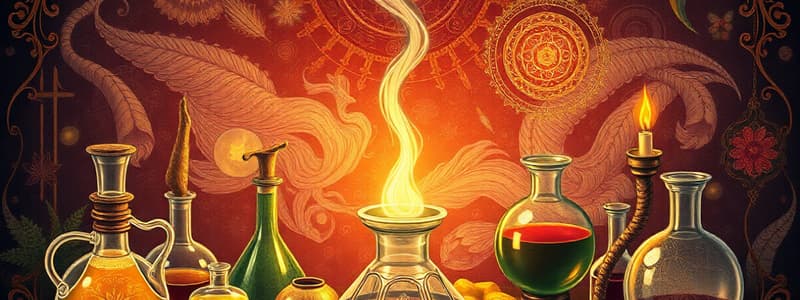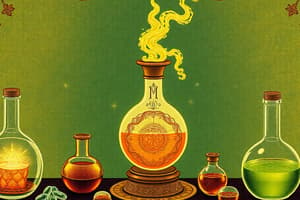Podcast
Questions and Answers
What was the primary search that led to the study of chemistry?
What was the primary search that led to the study of chemistry?
- To understand molecular structure
- To discover the philosopher's stone and the elixir of life (correct)
- To improve agricultural practices
- To develop modern scientific principles
What is the term for the ancient Indian practice related to chemistry?
What is the term for the ancient Indian practice related to chemistry?
- Metallurgy
- Rasayan Shastra (correct)
- Alchemy
- Iatrochemistry
Which of the following was NOT a focus of ancient Indian chemistry?
Which of the following was NOT a focus of ancient Indian chemistry?
- Cosmetics
- Metallurgy
- Electronics (correct)
- Medicine
What historical period saw the development of modern chemistry in Europe?
What historical period saw the development of modern chemistry in Europe?
What were the main two forms that chemistry developed from during 1300-1600 CE?
What were the main two forms that chemistry developed from during 1300-1600 CE?
What was believed to be the result of possessing the elixir of life?
What was believed to be the result of possessing the elixir of life?
Which metals were ancient alchemists particularly interested in transmuting into gold?
Which metals were ancient alchemists particularly interested in transmuting into gold?
Which ancient text highlights the significance of alkalis in Indian chemistry?
Which ancient text highlights the significance of alkalis in Indian chemistry?
What is the fixed numerical value of the speed of light in vacuum when expressed in the unit ms–1?
What is the fixed numerical value of the speed of light in vacuum when expressed in the unit ms–1?
Which constant is used to define the SI unit of mass, the kilogram?
Which constant is used to define the SI unit of mass, the kilogram?
The SI unit of time is based on the fixed numerical value of which frequency?
The SI unit of time is based on the fixed numerical value of which frequency?
What does the symbol 'kg' represent in the SI unit system?
What does the symbol 'kg' represent in the SI unit system?
How is the ampere defined in the SI unit system?
How is the ampere defined in the SI unit system?
What value is used to define the second in the SI unit system?
What value is used to define the second in the SI unit system?
Which of the following correctly defines the unit 'kelvin'?
Which of the following correctly defines the unit 'kelvin'?
Which is the correct expression for the Planck constant when expressed in the unit Js?
Which is the correct expression for the Planck constant when expressed in the unit Js?
What is the purpose of a unit factor in conversions?
What is the purpose of a unit factor in conversions?
If 1 day equals 24 hours, how many hours are in 3 days?
If 1 day equals 24 hours, how many hours are in 3 days?
How many centimeters are in 5 inches using the conversion factor 1 in = 2.54 cm?
How many centimeters are in 5 inches using the conversion factor 1 in = 2.54 cm?
How many minutes are there in 5 hours?
How many minutes are there in 5 hours?
What is the equivalent of 1 hour in seconds?
What is the equivalent of 1 hour in seconds?
What would be the result of converting 2 days into seconds?
What would be the result of converting 2 days into seconds?
Which of the following represents the conversion factor between centimeters and inches?
Which of the following represents the conversion factor between centimeters and inches?
If you were to convert 1 hour using the unit factors provided, what intermediary step would you use?
If you were to convert 1 hour using the unit factors provided, what intermediary step would you use?
What does the Law of Conservation of Mass state?
What does the Law of Conservation of Mass state?
Who is credited with formulating the Law of Definite Proportions?
Who is credited with formulating the Law of Definite Proportions?
In the context of Joseph Proust's work, how do gases combine?
In the context of Joseph Proust's work, how do gases combine?
What was a significant outcome of Lavoisier's experiments?
What was a significant outcome of Lavoisier's experiments?
What unit conversion is correctly represented by 1 m³?
What unit conversion is correctly represented by 1 m³?
Which statement correctly describes cupric carbonate samples in Proust's study?
Which statement correctly describes cupric carbonate samples in Proust's study?
How is the relationship between reactants and products important in chemical reactions according to Lavoisier?
How is the relationship between reactants and products important in chemical reactions according to Lavoisier?
Which of the following best describes the principle demonstrated by the Law of Conservation of Mass?
Which of the following best describes the principle demonstrated by the Law of Conservation of Mass?
What is the molar mass of water (H2O)?
What is the molar mass of water (H2O)?
What is the mass percent of oxygen in water (H2O)?
What is the mass percent of oxygen in water (H2O)?
In the example compound containing hydrogen, carbon, and chlorine, what is the mass percent of chlorine?
In the example compound containing hydrogen, carbon, and chlorine, what is the mass percent of chlorine?
How is the empirical formula determined from the mass percent composition?
How is the empirical formula determined from the mass percent composition?
What is the molar mass of the compound that contains 4.07% hydrogen, 24.27% carbon, and 71.65% chlorine?
What is the molar mass of the compound that contains 4.07% hydrogen, 24.27% carbon, and 71.65% chlorine?
What is the molecular formula of ethanol?
What is the molecular formula of ethanol?
Using a 100 g sample, how much carbon is present in the compound with given percentages?
Using a 100 g sample, how much carbon is present in the compound with given percentages?
What calculation provides the mass percent of an element in a compound?
What calculation provides the mass percent of an element in a compound?
Flashcards are hidden until you start studying
Study Notes
History of Chemistry
- Chemistry was not initially pursued for its own sake, but emerged from the search for two objectives:
- The Philosopher’s Stone (Paras) - a substance believed to transmute baser metals like iron and copper into gold.
- The Elixir of Life - a mythical potion thought to grant immortality.
- Ancient India possessed extensive knowledge of scientific phenomena, including:
- Metallurgy
- Medicine
- Cosmetics
- Glass making
- Dye production
Ancient Chemistry
- Ancient Indian chemistry was known as Rasayan Shastra, Rastantra, Ras Kriya, or Rasvidya.
- Alchemy and Iatrochemistry were dominant forms of chemistry during 1300-1600 CE.
- Modern chemistry took shape in 18th century Europe, building upon alchemical traditions introduced by Arabs.
Laws of Chemistry
- The Law of Conservation of Mass states that matter cannot be created or destroyed.
- This law was formulated by Lavoisier through precise measurements of reactant and product masses in carefully controlled experiments.
- The Law of Definite Proportions states that a given compound always contains exactly the same proportion of elements by weight, regardless of its source.
- The Law of Multiple Proportions states that when two elements combine to form more than one compound, the masses of one element that combine with a fixed mass of the other element are in a simple ratio.
- Gay-Lussac's Law of Combining Volumes states that when gases react, they do so in a simple ratio by volume, provided all gases are at the same temperature and pressure.
Applications and Calculations
- The empirical formula of a compound provides the simplest whole-number ratio of atoms present.
- The molecular formula of a compound expresses the actual number of atoms of each element present in a molecule.
- To determine the empirical and molecular formulas, you need the following data:
- Mass percentage of each element in the compound.
- Molar mass of the compound.
SI Units of Measurement
- Meter (m) - unit of length, defined by fixing the speed of light in vacuum (c) to be 299,792,458 ms-1, where the second is defined in terms of the caesium frequency (ΔνCs).
- Kilogram (kg) - unit of mass, defined by fixing the numerical value of the Planck constant (h) to be 6.62607015×10-34 J s, where the second and meter are defined in terms of c and ΔνCs.
- Second (s) - unit of time, defined by fixing the numerical value of the caesium frequency (ΔνCs) to be 9,192,631,770 Hz, where Hz is equal to s-1.
- Ampere (A) - unit of electric current, defined by fixing the numerical value of the elementary charge (e) to be 1.602176634×10-19 C.
- Kelvin (K) - unit of thermodynamic temperature.
Studying That Suits You
Use AI to generate personalized quizzes and flashcards to suit your learning preferences.




